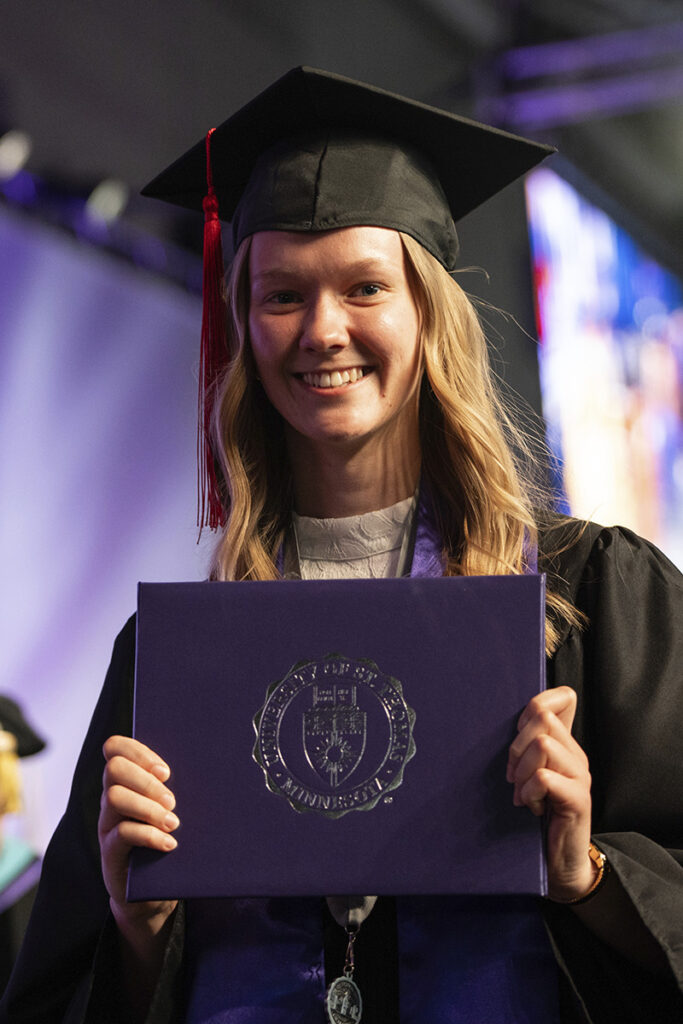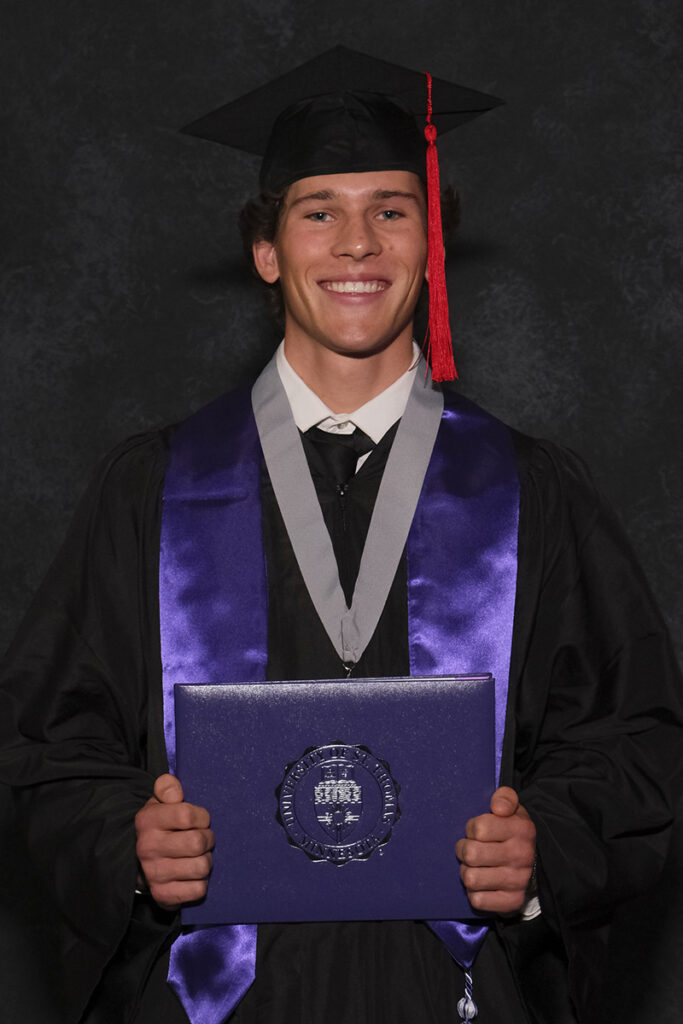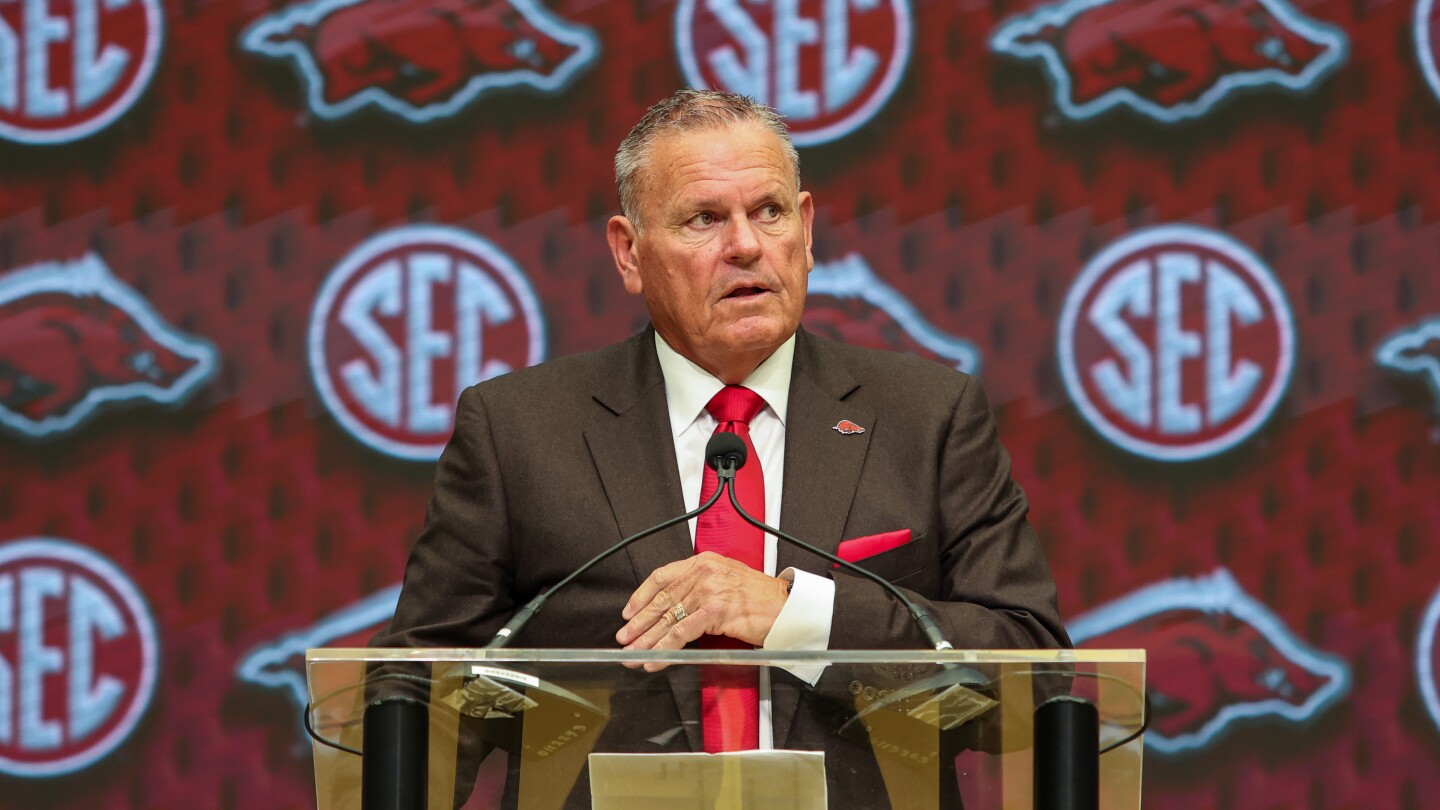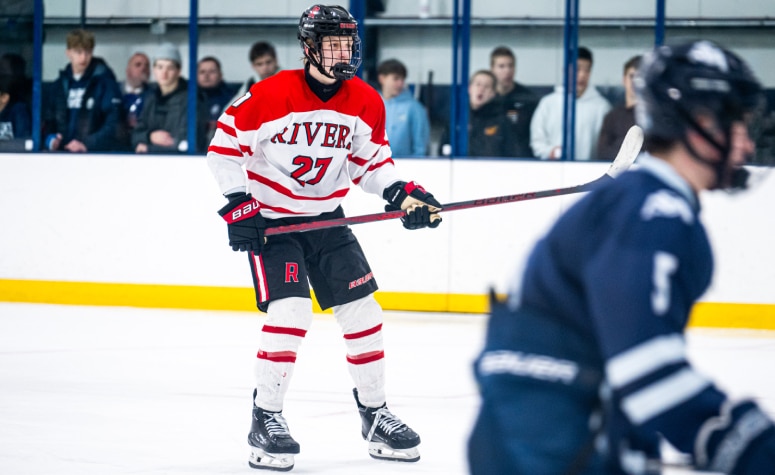College Sports
Acro and Stunt, NCAA Emerging Sport Rivals, Learn to Share the Mat
On May 15, the NCAA’s committee on women’s athletics recommended granting full championship status to two cheer-adjacent disciplines: acrobatics & tumbling and stunt. Set to take effect across all three divisions by spring 2027, the decision capped years of parallel—and often adversarial—campaigns for acceptance by college sports’ governing body. The announcement of their joint endorsement […]

On May 15, the NCAA’s committee on women’s athletics recommended granting full championship status to two cheer-adjacent disciplines: acrobatics & tumbling and stunt.
Set to take effect across all three divisions by spring 2027, the decision capped years of parallel—and often adversarial—campaigns for acceptance by college sports’ governing body. The announcement of their joint endorsement came just weeks before the final court approval of the House v. NCAA settlement and was made through simultaneous press releases, each highlighting the milestone in slightly different terms. Acrobatics & tumbling was described as having “made significant progress,” while stunt was credited with taking “a major leap forward.”
As part of the House settlement’s new participation parameters, stunt programs may now field up to 65 athletes, compared to 55 for A&T—an important allowance for institutions looking to meet gender equity targets through large, cost-effective rosters. The NCAA has welcomed both as important pathways to expand opportunities for women in sport.
Yet for those who spent the past two decades pushing their disciplines toward legitimacy, the idea of arriving at the finish line together feels more than a little surreal.
For much of their history, acrobatics & tumbling—a gymnastics-inspired outgrowth of early competitive cheer—and stunt—Varsity Brands’ effort to retool its all-star cheer model into an NCAA-friendly format—saw each other as direct competitors in a heads-up, zero-sum race for college admission.
“The sentiment we received so often from administrators and experienced people within college athletics is that only one will make it,” Janell Cook, executive director of the National Collegiate Acrobatics & Tumbling Association (NCATA), said.
“Both sports were building, and when you’re building something, you want to take care of that thing,” added Kentucky head stunt coach Blair Bergmann.
Their rivalry also served as a kind-of proxy battle over Varsity Brands’ longstanding (and legally scrutinized) grip on the entire cheerleading industry. The multibillion-dollar company—acquired last summer by private equity giant KKR—had regarded the NCAA’s involvement in the cheer space as a potential threat to its tightly controlled empire of camps, competitions and branding deals.
For those who saw Varsity’s dominance as a troubling concentration of power—if not an outright antitrust issue—the collegiate space offered a rare opportunity: a chance to build something outside the reach of a deeply entrenched corporate force.
“The first 10 years felt like you were straddling the line between proactive and reactive,” said Quinnipiac head A&T coach Mary Ann Powers, a trailblazer of her sport who has expressed concern about Varsity’s sway over the cheer world. “On one hand, I work at a university that was truly supporting it, not just with smoke and mirrors. But the reactive part is seeing the same sport—or what looks like the same sport—making progress and knowing that [Varsity] had all the antitrust [issues].”
Meanwhile, the uneasy launch of what was then called college competitive cheer—first introduced at the University of Maryland in 2003—rekindled concerns among Title IX advocates committed to ensuring that new women’s sports offered legitimate, equitable opportunities.
That tension would soon erupt into one of the most consequential gender equity battles in modern NCAA history.
In 2009, Powers’ Quinnipiac program joined forces with those at five other universities—Maryland, Oregon, Baylor, Azusa Pacific and Fairmont State—to formalize a new varsity sport blending elements of gymnastics and cheerleading. Their collective effort led to the creation of the NCATA in early 2010. Initially named the Collegiate Stunts and Tumbling Association, the group elected Oregon’s senior woman administrator Renee Baumgartner—a former collegiate golf coach—as its first president.
“Acro and tumbling was built on a strong foundation by administrators and coaches in the NCAA that wanted to provide opportunities to young girls,” Baumgartner said. “And we did it. We created the first NCAA female sport.”
At Quinnipiac, however, the rollout of this new sport quickly became embroiled in legal controversy. In an effort to save money, the university attempted to simultaneously cut women’s volleyball. That decision prompted a Title IX lawsuit filed by five volleyball players and the team’s head coach, alleging the school was disguising a club activity as a legitimate varsity sport to artificially inflate its female participation numbers.
The trial, which unfolded in spring 2009, featured testimony from both Powers and Varsity founder and CEO Jeff Webb—each making the case for or against competitive cheer’s (or Acrobatics & Tumbling’s) legitimacy as an NCAA-caliber sport.
“It continues to call itself cheer—which they don’t cheer and they don’t lead—which creates confusion with the classical cheerleader team,” Webb argued. “And they perform the same type of routine that classical cheerleaders have provided as part of their entertainment component for 25 years, which further confuses things.”
Despite Varsity’s previous admissions to the SEC, Webb insisted he had no issue with the formation of a new varsity sport so long as it didn’t undermine or compete with what he called “classical cheerleading.”
Powers countered on the witness stand, challenging whose rhetoric was the real threat.
“I think what offends [cheerleaders] more than anything is other women degrading them and knocking what they do,” she testified.
But Webb was not alone calling into question this new, cheer-like activity. The plaintiffs also drew on the expert testimony of Donna Lopiano, a prominent Title IX authority, college athletic administrator and former CEO of the Women’s Sports Foundation. Years earlier, Lopiano had played a key role in shaping the Department of Education’s 1979 guidelines on Title IX compliance in athletics and had since remained a vigilant observer of how educational institutions applied the law in practice.
In her expert report, Lopiano wrote, “QU should not be eliminating viable, existing women’s varsity sports and replacing them with an activity that has not been approved as a sport.” She pointed out the hastily assembled nature of the Quinnipiac cheer team, which lacked formal recruiting and coaching protocols, as evidence that the move was more strategic than substantive.
The court ruled in favor of the volleyball players, halting the planned elimination of the sport. In the verdict’s wake, the National Collegiate Acrobatics and Tumbling Association (NCATA) solidified an alliance with USA Gymnastics to officially sanction its competitions. Just days later, USA Cheer—a nonprofit supported by Varsity—put forward “STUNT,” in demonstrative all-caps, kicking off a decade-long battle for formal NCAA acceptance.
In 2011, the NCAA committee on women’s athletics (CWA) urged both organizations to collaborate on a unified sport proposal. However, each declined, opting instead to forge rival paths.
Acrobatics & tumbling was the first to advance. In 2018, the NCATA submitted its initial proposal for emerging sport status. The CWA endorsed it in 2019, followed by formal approval from the Division I Council in June 2020. That decision was conceivably influenced by the presence of Baumgartner, then NCATA president and athletic director at Santa Clara University, who held a seat on the D-I council at the time.
“I think it was pretty clear to everybody in the room that I advocated for acrobatics & tumbling,” Baumgartner admitted. “But you follow the rules and know exactly what benchmarks need to be met.”
By contrast, USA Cheer’s 2018 proposal to establish stunt as an emerging sport failed to secure initial approval from either the CWA or the NCAA’s strategic vision and planning committee. Reviewers determined the application lacked a clear explanation of how stunt was “philosophically and operationally separate” from traditional cheerleading, and how it would deliver a student-athlete experience comparable to other NCAA sports.
Undeterred, USA Cheer resubmitted its proposal for stunt in 2019 and received CWA approval in 2020. However, the process was paused for two years due to the COVID-19 pandemic. The effort regained momentum in 2022 when the CWA re-endorsed the sport.
Ahead of the 2023–24 academic year, stunt finally secured emerging status across all three NCAA divisions—drawing level with acrobatics & tumbling in the race toward full championship designation.
If, as expected, both disciplines receive that at the upcoming 2026 NCAA Convention, they will become the sixth and seventh women’s sports to do so under the emerging sports program, joining join rowing (1996), ice hockey (2000), water polo (2000), bowling (2003), beach volleyball (2015) and wrestling (2025).
Though their competition for NCAA recognition may be over, stunt and acrobatics & tumbling are now trying to secure institutional sponsorship from many of the same schools.
“I think most will pick one [sport] or the other for the fact that they aren’t in the position to add multiple programs,” said the NCATA’s Cook.
In making its case, stunt hails its direct lineage to the popular world of all-star cheerleading.
“Our whole entire sport was built from cheerleading skills,” noted USA Cheer CEO Lauri Harris, who estimates that approximately 95% of collegiate stunt athletes come from traditional cheerleading backgrounds.
Acrobatics & tumbling asserts its athletic diversity, drawing on a wide range of strengths from its participants.
According to NCATA survey data from the 2023–24 season, the largest share of collegiate acrobatics & tumbling athletes (approximately 43%) came from artistic gymnastics. Another 27% previously participated in competitive cheer, while 11% had backgrounds in spirit or sideline cheer.
In terms of format, the two emerging sports feature some key distinctions. Stunt is structured around head-to-head matchups, with two teams simultaneously performing the same compulsory routines across four quarters: partner stunts, pyramids and tosses, jumps and tumbling, and a final team routine. A&T, by contrast, resembles a gymnastics meet, with two or three teams competing in six categories—compulsory, acro, pyramid, toss, tumbling and team—separated by a halftime break.
Despite their differences, stunt and A&T are perhaps as closely related as any two college team sports.
“If someone walked into a gym, I don’t think the average person could tell whether they were watching acrobatics & tumbling or stunt,” Powers said.
For the upcoming 2025–26 season, there will be 66 varsity stunt programs at the collegiate level, including seven in Division I, compared to 49 acrobatics & tumbling teams—11 of which compete in D-I. Following the House settlement, one D-I institution, the University of West Georgia, chose to postpone launching its stunt program from 2026 to 2027.
According to USA Cheer, two other Division I schools that had been exploring stunt put those plans on hold after House, while two additional institutions have since begun seriously considering the sport in light of the ruling. (USA Cheer declined to name these four schools.)
In terms of athlete participation, the University of Kentucky boasts the largest stunt roster in the country, with 61 athletes on its team last season. That number far exceeds any other program nationwide. Kentucky—whose traditional cheerleading squad is a perennial powerhouse at Varsity’s UCA College Nationals—finished second to Cal Baptist at the 2025 USA Cheer College Stunt National Championship. Cal Baptist, by comparison, fielded a roster of 28 athletes.
Kentucky launched its stunt program during the 2021–22 academic year, amid a Title IX lawsuit filed in 2019 by two former students who alleged that the university failed to offer proportional athletic opportunities for women.
Why stunt instead acrobatics & tumbling?
“Cheerleading is very big in [the] state of Kentucky,” said Bergmann, the Wildcats’ head coach. “Stunt spoke more to that heritage.”
Prior to the House settlement, the NCAA had capped the number of scholarships for both stunt and acrobatics at 14. Although schools are now allowed to exceed that figure significantly for stunt, Bergmann said he expects Kentucky to remain at 14 scholarships for the upcoming year in order to keep the program cost-effective.
“We are at a point where the sport is so new and it is such at the ground level that basically what we do the next couple years is going to set the sport up for success in the next 20 years,” Bergmann said.
To be sure, schools are not required to choose between the two sports. Missouri State, for example, added both stunt and A&T last season, becoming only the second university to adopt both programs. (Hawaii Pacific, which previously sponsored A&T, also added stunt in the same year.)
Currently transitioning from FCS to FBS, Missouri State has acknowledged ongoing challenges in maintaining Title IX compliance—particularly as the female share of its student body has risen from 55% in 2008 to 61% in fall 2024. In an interview, Missouri State senior associate athletic director Casey Hunt made no bones about the fact that the stunt/A&T twofer was a gender-equity play, noting the relatively low cost and high roster capacity of both sports, especially post-House.
Both MSU teams now share the Hammons Student Center with MSU’s volleyball and swimming & diving programs, following a $2.7 million renovation that added a new weight room and dedicated locker rooms for stunt and A&T.
In their first spring season, Missouri State’s stunt team included 28 athletes, while its A&T team fielded 23. Both used the NCAA-allowed maximum of 14 scholarships. Hunt said the goal for the upcoming year is to grow each roster to between 30 and 35 athletes, with plans for continued expansion.
“We really could grow those to what, 120 [roster spots]?” Hunt said. “That becomes very significant for us, where maybe we don’t have to explore adding another sport program down the road, or we could just add individuals to one of those two programs, if not both.”
Since both sports compete in the spring, Missouri State has not experienced any athlete crossover—and likely won’t. Still, Hunt noted that the coaching staffs actively collaborate on recruiting.
The skill overlap between stunt and sideline cheerleading means that schools can feasibly transition existing cheer squads into varsity stunt teams. Hunt predicted that traditional sideline squads could increasingly lose ground to both sports, a shift she says is already evident on MSU’s campus.
“I think part of that is [A&T and stunt] get scholarships, there is a competitive aspect, you get the travel, you get the gear,” Hunt said.
USA Cheer’s Harris, however, downplays the fear of that kind of cannibalization.
“There’s such a small number of opportunities at the college level for cheer that we really haven’t seen a lot of athletes have to make a choice,” Harris said. “This has just kind of expanded more opportunities for high school cheerleaders to actually do something in college.”
To that end, the battle-wearied advocates of acrobatics & tumbling and stunt say they’re ready to embrace a future of co-existence.
“Since the NCAA has chosen to [have] them both, who am I to say it should be one or the other?” said Powers. “I don’t feel that way anymore.”
College Sports
LSU Tigers Gymnastics Adds Boise State Graduate Transfer to 2026 Roster
BATON ROUGE – The LSU Gymnastics program announced the final piece to their 2026 roster on Tuesday as Boise State graduate transfer Courtney Blackson is set to join the Tigers this upcoming fall. Blackson achieved one of the most successful careers with the Broncos from 2021-2024, where she individually advanced to nationals two years in a […]

BATON ROUGE – The LSU Gymnastics program announced the final piece to their 2026 roster on Tuesday as Boise State graduate transfer Courtney Blackson is set to join the Tigers this upcoming fall.
Blackson achieved one of the most successful careers with the Broncos from 2021-2024, where she individually advanced to nationals two years in a row, including being the national vault runner up in 2023.
She was a nominee for the AAI Award in 2024, which is given to the top senior gymnast in the nation.
“I am incredibly grateful to be spending my fifth year of eligibility at LSU! From the moment I stepped on campus, there was a palpable feeling of belonging that confirmed this was exactly where I was meant to be,” said Blackson.
“I felt truly seen, valued, and inspired from the moment I first connected with the coaching staff, and their genuine belief in me as both an athlete and a person fostered a sense of purpose and belonging that I couldn’t overlook.
“LSU’s culture balances the pursuit of excellence with a strong sense of family, empowering every athlete not just to develop their skills but also to grow as individuals. I feel honored to join a community that challenges me, believes in me, and celebrates every step of my journey with sincerity and compassion.”
Blackson entered the transfer portal a year after completing her final year at Boise State in 2024. Now, the two-time All-American out of Elk Grove, California, plans to use her final year of eligibility with the two-time defending SEC Champions at LSU.
Blackson adds depth on three events for the Tigers this upcoming season.
She competed in all but three meets throughout her four years at Boise State and owns career bests of 10.000 on vault and 9.950 on bars and floor.
Blackson’s Career Accolades:
LSU Football, Texas Longhorns and Michigan Wolverines Trending in Recruiting
LSU Football and Notre Dame Fighting Irish Making Early Impression on Top Cornerback
No. 1 Athlete in America, Five-Star LSU Football Commit Helping Recruit Top Prospect
Follow Zack Nagy on Twitter: @znagy20 and LSU Tigers On SI: @LSUTigersSI for all coverage surrounding the LSU Tigers.
College Sports
St. Thomas Students Go ‘Beyond the Buzzer’ in Collaboration With Athletics – Newsroom
When College of Arts and Sciences (CAS) Dean Bill Tolman and Vice President and Director of Athletics Phil Esten began discussing opportunities for a collaboration, they knew one thing: They wanted University of St. Thomas students to be at the center of the project. The result is a student-driven series of video shorts called “Beyond […]

When College of Arts and Sciences (CAS) Dean Bill Tolman and Vice President and Director of Athletics Phil Esten began discussing opportunities for a collaboration, they knew one thing: They wanted University of St. Thomas students to be at the center of the project. The result is a student-driven series of video shorts called “Beyond the Buzzer” and delivered in a big way.
The series was filmed, edited and produced by Digital Media Arts students Corina Sandy ’25 and Max Lidtke ’25, and then released in a social media campaign. Topics covered included sports medicine, broadcast production, gym setup and a preview of the Lee & Penny Anderson Arena, which will host its first competitive events this fall and winter for men’s and women’s basketball and ice hockey.
“This collaboration between Athletics and CAS provided an impactful learning experience for the students,” Tolman said. “Corina and Max were empowered to express their creative energy and skills to tell stories about people working behind the scenes to support athletic events and programs.”

Corina Sandy ’25
Major: Digital Media Arts
Minors: Catholic Studies, Theology
Hometown: Zimmerman, Minnesota
Future Plans: This summer I’ve begun doing wedding videography more full time, and I also manage social media at Cal & Lily Flower Farm. For the future, we will see where God takes me. I just know I will always be doing videography in some way!
The duo were a natural fit for the project. In addition to their time studying Digital Media Arts at St. Thomas, both had previously worked as members of Tommie Athletic Productions. (TAP). “Our idea was inspired by our personal experiences working with TAP and our desire to highlight the behind-the-scenes work,” Sandy said. “That led us to think about all the other roles within Athletics that many students and supporters may not be aware of.”
“Corina and Max are two very talented folks. To see them work, grow, and thrive in their time at St. Thomas, culminating in their excellent output on this keystone project, was special,” said Assistant Athletic Director and TAP lead Mike Gallagher, who connected the students with subject matter experts and oversaw the final editing process.
Max Lidtke ’25
Major: Digital Media Arts
Hometown: Hastings, Minnesota
Future Plans: My goal is to work in the NHL as a videographer/editor. I am currently a video production intern for the St. Louis Blues so my goals are becoming much more tangible!

Sandy and Lidtke both commented on the value of hands-on, experiential learning emphasized in the College of Arts and Sciences. Lidtke said that “this is the best type of learning. We get to use everything we already know to solve a problem or create something – and when we need help, it’s there.”
Dr. Peter Gregg, an associate professor and chair in the Emerging Media Department, provided key guidance throughout the project, often meeting weekly with Corina and Max to brainstorm topics and develop a robust proposal to pitch to Tolman and Gallagher. “Beyond the Buzzer reflects a student-led, professional media production experience,” Gregg said. “Being able to take the skills they’ve learned in their coursework and connect it to a Division I athletics organization is a significant opportunity and challenge, and the students succeeded in what they set out to do.”
As St. Thomas seeks to expand its impact and visibility as a national Catholic university, academic and athletic excellence will both play critical roles. “This is an area of great opportunity,” Tolman added. “I’m excited by this and other occasions for CAS and Athletics to work together to drive the university forward.”
This experience helped grow my confidence as a creator, pushing me to make decisions and trust them. I often remind myself, ‘Act confident and no one will question you,’ and I found myself leaning on that mindset often as I navigated a more professional environment as a student.
— Corina sandy ’25
College Sports
Coaches race to master art of retention amid NIL, revenue sharing and transfer portal challenges
Whether it was an ACC, SEC, Big Ten or Big 12 coach taking the podium at media days, one theme remained consistent: In an era where revenue sharing and NIL opportunities can swiftly steer athletes toward the transfer portal, programs across the country are racing to master the art of player retention. Its importance is […]

Whether it was an ACC, SEC, Big Ten or Big 12 coach taking the podium at media days, one theme remained consistent: In an era where revenue sharing and NIL opportunities can swiftly steer athletes toward the transfer portal, programs across the country are racing to master the art of player retention.
Its importance is clear to Arkansas coach Sam Pittman, who has seen all but five players from his 2023 recruiting class leave for different programs.
“Here’s what it’s not because of: the way they’re treated, because of the way they’re developed, because of the way they’re taught,” he said. “That’s not the reason. It could be playing time. It could be finances. Probably the majority of it is finances, but you’d have to ask those guys.”
More than 3,000 Bowl Subdivision players reportedly entered the transfer portal this past spring, which would average out to about 22 players per team. For the Razorbacks, 10 starters will be back and one of them is senior defensive lineman Cam Ball. He has remained with Arkansas his entire career, a somewhat rare occurrence for an NFL hopeful these days.
“I’m just a loyal guy. I’m loyal to the state of Arkansas; Arkansas has been loyal to me,” Ball said.
Arkansas, like many schools, is also trying to scare up more money from donors as it faces the financial ramifications of the $2.8 billion House settlement; last fall, the athletic director said the school needed some $12 million more annually to “be in the NIL game from a football perspective.” Besides the money, the Razorbacks have to find talented players; Ball grew up in Atlanta, just barely within the regional footprint in which Pittman prefers to recruit.
“We have to go outside our state,” Pittman said. “In-state recruiting has changed over the last three or four years because of NIL. So you have to think about the talent — who it is versus what pay is expected. So that’s been a little bit more difficult in our state.”
Pittman isn’t the only coach who wants prospects to be familiar with what their college experience will look like before making any life-changing decisions. Florida coach Billy Napier paints a clear picture of life in Gainesville and the challenges and perks that come with it.
“We present our product in a way where we’re selling the degree, the alumni network, the Gator-made program, and you have to be up for the challenge of trying to get Florida back to where it’s been before,” he said. “And I think that’s one of the reasons we’ve been able to keep it together.”
Florida’s 2023 recruiting class remains mostly intact, and from Napier’s perspective, hungrier than ever. Compared to other SEC teams, the Gators have had more success with retention. Napier doesn’t think it’s a coincidence.
“We told them when they came in, you know, look, it’s not going to be all sunshine and rainbows here. We’re in this thing for the long haul,” Napier said. “I think a lot of this is how you pitch it in recruiting. We’re going to continue to do that, and retention is more important than it’s ever been.”
Coaches scrambling to prevent transfers and maintain consistency isn’t exclusive to the SEC. The approval of the House settlement is a double-edged sword when it comes to retention, and Power Four schools and beyond are feeling the effects. Third-party NIL deals are no longer the only negotiation tactic schools need to worry about.
Complex contracts are becoming common and legal risks grow for athletes and programs alike as college football increasingly resembles the pros. Some deals are being negotiated solely by athletes as young as 18.
As a redshirt senior, Louisville linebacker TJ Quinn is used to the process.
“I wouldn’t say I was nervous (to negotiate) because this is my third year of having to do that,” Quinn said. “You’ve got to kind of stand your ground with what you feel like is your worth. If you’re comfortable with their offer, then sign. Then you have some guys that’ll leave and go to schools to get more money and stuff. That was never really like a big pusher for me, to go out and get more money because I feel like I’m in a good situation here at Louisville.”
Quinn’s loyalty could be the most convincing negotiation tactic of them all. While programs use revenue-share dollars to sway prospective transfers, coaches have begun to reward loyalty.
“To some degree, it’s capitalism that you get what you earn. So the guys that go out and play well are going to get more than the guys who haven’t proven it yet,” SMU coach Rhett Lashlee said. “Everybody on the team’s not going to make the same. Fair doesn’t always mean equal.”
But he also said the Mustangs are not going to add players “making a whole lot more than those guys who have already earned it here.”
“And I think that’s what helps us keep a good culture, is try to start with: Let’s retain first, and then whatever’s left, let’s go build the best team we can for those guys,” Lashlee said.
North Carolina State’s Dave Doeren doubled down.
“A guy that’s been on a team three years, that’s playing well and earned it on the field should make more than a guy coming in the door. I think that’s a proper way to do business,” Doeren said, though he warned that might not be the case across the board. “Right now, common sense is not prevailing in college football.”
College Sports
23 forwards to watch for Aug. 1
Carter Meyer is accelerating to be a junior. (Robert Chalmers/Cohen’s Hockey) This will be an interesting opening to college recruitment. For starters, there are high-end players that colleges are already recruiting hard. There is a slew of forwards who are pretty easily projectable as impact college hockey players. On defense, there is quite a bit […]


Carter Meyer is accelerating to be a junior. (Robert Chalmers/Cohen’s Hockey)
This will be an interesting opening to college recruitment.
For starters, there are high-end players that colleges are already recruiting hard. There is a slew of forwards who are pretty easily projectable as impact college hockey players. On defense, there is quite a bit of size, which has become all the rage for defensemen these days.
However, this recruiting cycle will be most interesting because of what happened last year: the CHL ruling.
With CHL players now eligible to play NCAA Division 1 hockey, there will likely be heavy implications on recruiting.
Will programs send out fewer offers? Will they wait for many of these players to develop further, pitting them against current CHL players?
And on the other side of it, will recruits be more hesitant to commit somewhere because of how many CHL players that school is taking in?
Time will tell.
Here are the top first-year eligible forwards to watch come Aug. 1, which is when rising juniors in high school can accept an offer. A separate story will be run on defensemen and goalies.
College Sports
Coaches race to master art of retention amid NIL, revenue sharing and transfer portal challenges
Whether it was an ACC, SEC, Big Ten or Big 12 coach taking the podium at media days, one theme remained consistent: In an era where revenue sharing and NIL opportunities can swiftly steer athletes toward the transfer portal, programs across the country are racing to master the art of player retention. Its importance is […]

Whether it was an ACC, SEC, Big Ten or Big 12 coach taking the podium at media days, one theme remained consistent: In an era where revenue sharing and NIL opportunities can swiftly steer athletes toward the transfer portal, programs across the country are racing to master the art of player retention.
Its importance is clear to Arkansas coach Sam Pittman, who has seen all but five players from his 2023 recruiting class leave for different programs.
“Here’s what it’s not because of: the way they’re treated, because of the way they’re developed, because of the way they’re taught,” he said. “That’s not the reason. It could be playing time. It could be finances. Probably the majority of it is finances, but you’d have to ask those guys.”
More than 3,000 Bowl Subdivision players reportedly entered the transfer portal this past spring, which would average out to about 22 players per team. For the Razorbacks, 10 starters will be back and one of them is senior defensive lineman Cam Ball. He has remained with Arkansas his entire career, a somewhat rare occurrence for an NFL hopeful these days.
“I’m just a loyal guy. I’m loyal to the state of Arkansas; Arkansas has been loyal to me,” Ball said.
Arkansas, like many schools, is also trying to scare up more money from donors as it faces the financial ramifications of the $2.8 billion House settlement; last fall, the athletic director said the school needed some $12 million more annually to “be in the NIL game from a football perspective.” Besides the money, the Razorbacks have to find talented players; Ball grew up in Atlanta, just barely within the regional footprint in which Pittman prefers to recruit.
“We have to go outside our state,” Pittman said. “In-state recruiting has changed over the last three or four years because of NIL. So you have to think about the talent — who it is versus what pay is expected. So that’s been a little bit more difficult in our state.”
Pittman isn’t the only coach who wants prospects to be familiar with what their college experience will look like before making any life-changing decisions. Florida coach Billy Napier paints a clear picture of life in Gainesville and the challenges and perks that come with it.
“We present our product in a way where we’re selling the degree, the alumni network, the Gator-made program, and you have to be up for the challenge of trying to get Florida back to where it’s been before,” he said. “And I think that’s one of the reasons we’ve been able to keep it together.”
Florida’s 2023 recruiting class remains mostly intact, and from Napier’s perspective, hungrier than ever. Compared to other SEC teams, the Gators have had more success with retention. Napier doesn’t think it’s a coincidence.
“We told them when they came in, you know, look, it’s not going to be all sunshine and rainbows here. We’re in this thing for the long haul,” Napier said. “I think a lot of this is how you pitch it in recruiting. We’re going to continue to do that, and retention is more important than it’s ever been.”
Coaches scrambling to prevent transfers and maintain consistency isn’t exclusive to the SEC. The approval of the House settlement is a double-edged sword when it comes to retention, and Power Four schools and beyond are feeling the effects. Third-party NIL deals are no longer the only negotiation tactic schools need to worry about.
Complex contracts are becoming common and legal risks grow for athletes and programs alike as college football increasingly resembles the pros. Some deals are being negotiated solely by athletes as young as 18.
As a redshirt senior, Louisville linebacker TJ Quinn is used to the process.
“I wouldn’t say I was nervous (to negotiate) because this is my third year of having to do that,” Quinn said. “You’ve got to kind of stand your ground with what you feel like is your worth. If you’re comfortable with their offer, then sign. Then you have some guys that’ll leave and go to schools to get more money and stuff. That was never really like a big pusher for me, to go out and get more money because I feel like I’m in a good situation here at Louisville.”
Quinn’s loyalty could be the most convincing negotiation tactic of them all. While programs use revenue-share dollars to sway prospective transfers, coaches have begun to reward loyalty.
“To some degree, it’s capitalism that you get what you earn. So the guys that go out and play well are going to get more than the guys who haven’t proven it yet,” SMU coach Rhett Lashlee said. “Everybody on the team’s not going to make the same. Fair doesn’t always mean equal.”
But he also said the Mustangs are not going to add players “making a whole lot more than those guys who have already earned it here.”
“And I think that’s what helps us keep a good culture, is try to start with: Let’s retain first, and then whatever’s left, let’s go build the best team we can for those guys,” Lashlee said.
North Carolina State’s Dave Doeren doubled down.
“A guy that’s been on a team three years, that’s playing well and earned it on the field should make more than a guy coming in the door. I think that’s a proper way to do business,” Doeren said, though he warned that might not be the case across the board. “Right now, common sense is not prevailing in college football.”
___
AP Sports Writer Aaron Beard contributed to this report.
___
AP college football: https://apnews.com/hub/college-football
College Sports
Eric Podbelski – Baseball Coach
Eric Podbelski is in his first season as the associate head coach of the Bears’ in 2026. With nearly three decades of collegiate head coaching experience under his belt, Podbelski came to College Hill in July 2025 to join Frank Holbrook’s staff, who was one of his former players at Wheaton. Podbelski served as […]

Podbelski served as the head coach at Wheaton for the first 28 years of the program’s existence, starting with its inaugural season in 1998. During his tenure, he posted an 817-342-5 overall record, the 15th-most wins among active Division III coaches as of 2025, while his .704 winning percentage was seventh-best among active coaches. The Lyons also never had a losing season during that time, qualifying for all 25 NEWMAC postseason Tournaments, three 40+ win seasons and 14 campaigns with at least 30 victories.
A model of consistency and excellence in his 28 seasons, Podbelski’s squads captured at least a share of 21 NEWMAC regular season titles, 17 tournament championships, made 18 NCAA Tournaments, and four trips to the Division III College World Series, including a pair of national runner-up finishes in 2006 and 2012. Wheaton earned at least a share of the NEWMAC regular season crown 17 years in a row, with Podbelski earning 12 NEWMAC Coach of the Year/Staff of the Year honors, six NEIBA Coach of the Year honors, and was selected as the regional coach of the year five times.
Podbelski coached 114 All-NEWMAC selections, as well as 132 all-region honorees and 21 All-Americans. Sixteen of his players were also named NEWMAC Players of the Year. Nine of his former players went on to sign professionally, including MLB veteran Chris Denorfia.
Podbelski graduated from Brandeis in 1991 where he finished among the school’s career leaders in wins with 23. He played one summer in the Cape Cod League with the Falmouth Commodores.
HEAD COACHING RECORDS
| Seasons | School | Overall | Pct. | Conference | Conf. Pct. |
|---|---|---|---|---|---|
| 1998-2025 | Wheaton | 817-342-5 | .704 | 297-75 | .798 |
COACHING TIMELINE
| Season | School | Title |
|---|---|---|
| 1993-1997 | Brandeis | Assistant Coach |
| 1998-2025 | Wheaton | Head Coach |
| 2026-present | Brown | Associate Head Coach |
-

 Fashion2 weeks ago
Fashion2 weeks agoEA Sports College Football 26 review – They got us in the first half, not gonna lie
-

 Health2 weeks ago
Health2 weeks agoCAREGD Trademark Hits the Streets for Mental Health Month
-

 Youtube3 weeks ago
Youtube3 weeks agoWill Giannis DEPART Milwaukee⁉️ + How signing Turner & waiving Dame impacts the Bucks | NBA Today
-

 Sports2 weeks ago
Sports2 weeks agoVolleyball Releases 2025 Schedule – Niagara University Athletics
-

 Sports2 weeks ago
Sports2 weeks agoNew NCAA historical database provides wealth of information on championships
-

 Sports2 weeks ago
Sports2 weeks agoAdapti, Inc. (OTC
-

 College Sports3 weeks ago
College Sports3 weeks agoBuford DB Tyriq Green Commits to Georgia
-

 High School Sports5 days ago
High School Sports5 days ago100 days to men's college basketball
-

 Youtube3 weeks ago
Youtube3 weeks agoThe Twins squeeze out a walk-off win 👀
-

 Rec Sports1 week ago
Rec Sports1 week agoFlorida woman, 20, accused of pepper-spraying rich men in Miami Beach hotels, stealing their luxury watches



























